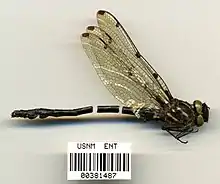| Phyllopetalia | |
|---|---|
 | |
| Phyllopetalia excrescens | |
| Scientific classification | |
| Domain: | Eukaryota |
| Kingdom: | Animalia |
| Phylum: | Arthropoda |
| Class: | Insecta |
| Order: | Odonata |
| Infraorder: | Anisoptera |
| Family: | Austropetaliidae |
| Genus: | Phyllopetalia Selys, 1858[1] |
| Type species | |
| Phyllopetalia stictica Hagen in Selys, 1858 | |
| Synonyms[2] | |
| |
Phyllopetalia is a genus of dragonflies in the family Austropetaliidae. They are commonly known as redspots.
All the species are endemic to Chile except for P. pudu which also occurs in Argentina.
The genus contains the following species:[3]
- Phyllopetalia altarensis (Carle, 1996) - Metropolitan Redspot[4]
- Phyllopetalia apicalis Selys, 1858 - Narrow-flanged Redspot[5]
- Phyllopetalia apollo Selys, 1878 - Apollo Redspot[6]
- Phyllopetalia excrescens (Carle, 1996) - Peaked Redspot[7]
- Phyllopetalia pudu Dunkle, 1985 - Pudu Redspot[8]
- Phyllopetalia stictica Hagen in Selys, 1858 - Unicorn Redspot[9]
References
- ↑ De Selys Longchamps, Edm.; Hagen, H. A. (1858). "Sous-genre II.—Phyllopétalie (Phyllopetalia), De Selys". Monographie de Gomphines. Bruxelles et Leipzig: C. Muquardt. pp. 616–621.
- ↑ Garrison, Rosser W.; von Ellenrieder, Natalia; Louton, Jerry A. (2006). "Phyllopetalia". Dragonfly Genera of the New World: An illustrated and annotated key to the Anisoptera. Baltimore: JHU Press. p. 22.
- ↑ Martin Schorr; Martin Lindeboom; Dennis Paulson. "World Odonata List". University of Puget Sound. Retrieved 11 August 2010.
- ↑ von Ellenrieder, N. & Paulson, D. (2006). "Phyllopetalia altarensis". IUCN Red List of Threatened Species. 2006: e.T59756A12014533. doi:10.2305/IUCN.UK.2006.RLTS.T59756A12014533.en. Retrieved 24 December 2017.
- ↑ von Ellenrieder, N. (2009). "Phyllopetalia apicalis". IUCN Red List of Threatened Species. 2009: e.T63232A12641779. doi:10.2305/IUCN.UK.2009-2.RLTS.T63232A12641779.en. Retrieved 24 December 2017.
- ↑ von Ellenrieder, N. & Paulson, D. (2007). "Phyllopetalia apollo". IUCN Red List of Threatened Species. 2007: e.T63233A12642109. doi:10.2305/IUCN.UK.2007.RLTS.T63233A12642109.en. Retrieved 24 December 2017.
- ↑ von Ellenrieder, N. & Paulson, D. (2006). "Phyllopetalia excrescens". IUCN Red List of Threatened Species. 2006: e.T59757A12014626. doi:10.2305/IUCN.UK.2006.RLTS.T59757A12014626.en. Retrieved 24 December 2017.
- ↑ von Ellenrieder, N. (2009). "Phyllopetalia pudu". IUCN Red List of Threatened Species. 2009: e.T59758A12014715. doi:10.2305/IUCN.UK.2009-2.RLTS.T59758A12014715.en. Retrieved 24 December 2017.
- ↑ von Ellenrieder, N. (2009). "Phyllopetalia stictica". IUCN Red List of Threatened Species. 2009: e.T59759A12014989. doi:10.2305/IUCN.UK.2009-2.RLTS.T59759A12014989.en. Retrieved 24 December 2017.
Further reading
- Dunkle, S. W. (1985). "Phyllopetalia pudu spec. nov., a new dragonfly from Chile, with a key to the family (Anisoptera: Neopetaliidae)". Odonatologica. 14 (3): 191–199.
- Carle, F. L. (1996). "Revision of Austropetaliidae (Anisoptera: Aeshnoidea)". Odonatologica. 25 (3): 231–259.
- von Ellenrieder, Natalia (2005). "Taxonomy of the South American Phyllopetalia (Odonata: Austropetaliidae)". International Journal of Odonatology. 8 (2): 311–352. doi:10.1080/13887890.2005.9748258. hdl:11336/54397. S2CID 219598061.
This article is issued from Wikipedia. The text is licensed under Creative Commons - Attribution - Sharealike. Additional terms may apply for the media files.